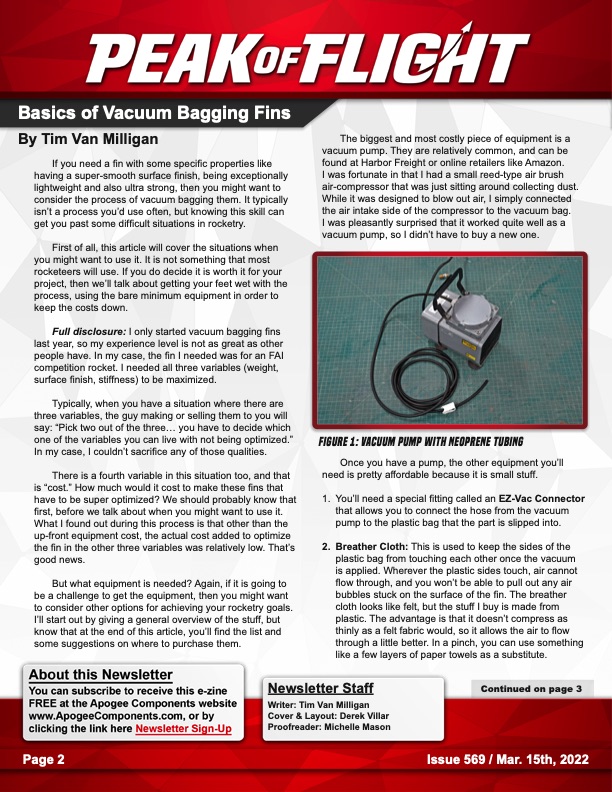
PDF Publication Title:
Text from PDF Page: 002
Basics of Vacuum Bagging Fins Continued on page 3 By Tim Van Milligan If you need a fin with some specific properties like having a super-smooth surface finish, being exceptionally lightweight and also ultra strong, then you might want to consider the process of vacuum bagging them. It typically isn’t a process you’d use often, but knowing this skill can get you past some difficult situations in rocketry. First of all, this article will cover the situations when you might want to use it. It is not something that most rocketeers will use. If you do decide it is worth it for your project, then we’ll talk about getting your feet wet with the process, using the bare minimum equipment in order to keep the costs down. Full disclosure: I only started vacuum bagging fins last year, so my experience level is not as great as other people have. In my case, the fin I needed was for an FAI competition rocket. I needed all three variables (weight, surface finish, stiffness) to be maximized. Typically, when you have a situation where there are three variables, the guy making or selling them to you will say: “Pick two out of the three... you have to decide which one of the variables you can live with not being optimized.” In my case, I couldn’t sacrifice any of those qualities. There is a fourth variable in this situation too, and that is “cost.” How much would it cost to make these fins that have to be super optimized? We should probably know that first, before we talk about when you might want to use it. What I found out during this process is that other than the up-front equipment cost, the actual cost added to optimize the fin in the other three variables was relatively low. That’s good news. But what equipment is needed? Again, if it is going to be a challenge to get the equipment, then you might want to consider other options for achieving your rocketry goals. I’ll start out by giving a general overview of the stuff, but know that at the end of this article, you’ll find the list and some suggestions on where to purchase them. The biggest and most costly piece of equipment is a vacuum pump. They are relatively common, and can be found at Harbor Freight or online retailers like Amazon. I was fortunate in that I had a small reed-type air brush air-compressor that was just sitting around collecting dust. While it was designed to blow out air, I simply connected the air intake side of the compressor to the vacuum bag. I was pleasantly surprised that it worked quite well as a vacuum pump, so I didn’t have to buy a new one. Figure 1: Vacuum pump with Neoprene tubing Once you have a pump, the other equipment you’ll need is pretty affordable because it is small stuff. 1. You’ll need a special fitting called an EZ-Vac Connector that allows you to connect the hose from the vacuum pump to the plastic bag that the part is slipped into. 2. Breather Cloth: This is used to keep the sides of the plastic bag from touching each other once the vacuum is applied. Wherever the plastic sides touch, air cannot flow through, and you won’t be able to pull out any air bubbles stuck on the surface of the fin. The breather cloth looks like felt, but the stuff I buy is made from plastic. The advantage is that it doesn’t compress as thinly as a felt fabric would, so it allows the air to flow through a little better. In a pinch, you can use something like a few layers of paper towels as a substitute. Newsletter Staff Writer: Tim Van Milligan Cover & Layout: Derek Villar Proofreader: Michelle Mason Page 2 Issue 569 / Mar. 15th, 2022PDF Image | Basics of Vacuum Bagging Fins

PDF Search Title:
Basics of Vacuum Bagging FinsOriginal File Name Searched:
Newsletter569.pdfDIY PDF Search: Google It | Yahoo | Bing
5,000 BF Shipping Container Lumber Dry Kiln For Quality Lumber The 5,000 BF container kiln consists of one 40 foot high-cube aluminum shipping container... More Info
Shipping Container Lumber Dry Kilns by Global Energy Global Energy designed and developed the container kiln back in 1991. The purpose is to give access to portable sawmill owners, furniture makers, and small business the value added profit of dry kiln lumber and quality hardwoods... More Info
Vacuum Kiln Conversion Kit for Lumber and Wood Dry Kilns Convert your existing conventional dry kiln into a fast drying vacuum kiln. Similar to vacuum bagging in the boat building and aircraft industry, we have come up with a proprietary process which allows you to build a very simple vacuum kiln at a fraction of the price, and without the intensive conventional metal chamber structure... More Info
Vacuum Pump Cart System for Bagging Clamping Wood Drying and more Vacuum Cart with 2HP Pump and Dual Pistons with multiple multiplex vacuum ports and liquid reservoir... More Info
Vacuum Bagging Basics Vacuum bagging is a method of clamping, which has traditionally been used in the composites industry, but can also be used for vacuum drying materials, including wood products... More Info
| CONTACT TEL: 608-238-6001 Email: greg@globalmicroturbine.com | RSS | AMP |